|
The Japanese attack on Pearl Harbor
was a year away when this article would have been written, given that it appeared in the January
1941 issue of Flying Aces magazine.
Major Frederic
Ives Lord preferred a light-weight, inexpensive, more expendable type of aircraft like
the P-40 Warhawk than something like a P-51 Mustang. His thinking being that it would be more
effective to overwhelm the enemy with massive squadrons of airplanes that could be quickly
replaced (and pilots, too?) rather than recovering and repairing battle-damaged aircraft (and
their air crew). In fact, the major envisioned mostly enlisted pilots, akin to the expendable
crewmen in Star Trek - usually identifiable by their red shirts - that could be lost with
less mission impact than highly trained and educated officers. Major Lord as a decorated and
brave man, but seems somewhat cold and impersonal in planning, but then again consider Operation
Overlord and the massive casualties suffered in those few days. When the fate of the free
world hangs in the balance, you do what it takes, I suppose. In retrospect, however, I think
it is safe to say that Major Lord's vision of the American air force would not have done well
against what the Germans and Japanese had in store for us in World War II.
Author of "Do College Men Fly Better?"
by Major Fred Lord
"Close Calls in Russia," etc.
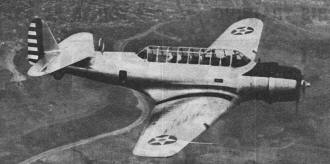
Vultee YA-19's are in Air Corps service, but Major Lord believes that all-metal
ships of this type are unnecessary. "After all," he argues, "in war a plane's life is very
short."
A real, fighting flyer airs his pet peeves against our Army Air Force system, and tells
exactly what is wrong and what should be done to make for a better air arm. In Major Lord's
usual style, no punches are pulled in this article!
When you hear the word "streamlined" you automatically think of airplanes. American airplanes
are streamlined and our air services should be - but aren't. They're still modeled after the
aviation of the first World War. One of the errors of generals always has been to predicate
the future war on lessons learned in the last one; such-and-such a tactic was good then, they
think, so improve on it and it should go over even better in the next fracas. They seem to
lack vision and imagination and only soar physically; ancient theories and army manuals have
their mentality rooted to earth.
Our Army is being remodeled along modern, mobile requirements - streamlined, the doughboy
says. But, alas, the air services aren't. Well, let's have some fun, tear them to pieces,
and then rebuild them as a fighting unit instead of a glamorous social fraternity.
So pull up your chair to the round-table. Your companions are Billy Mitchell's dauntless
spirit, a French minister of that humbled nation, an RAF ace, a German air-general, and a
Loyalist Spanish war-bird. From this group we should learn of mistakes in organization and
procurement and of victories of imagination and coordination.
Today, the airplane is acknowledged to be the weapon of aggressive warfare. In Hitler's
conquests, airpower has played a major role. And in Hitler's army, no admiral or infantry
general tells the Air Force what to do, or how. But in our air services, the admiral orders
one group of flyers and the general another. Each cooperates with the other about as much
as the doughboy with the gob when there's a pretty girl in sight. But they've got to get together
or the girl will walk off while they're struggling to see who gets her.
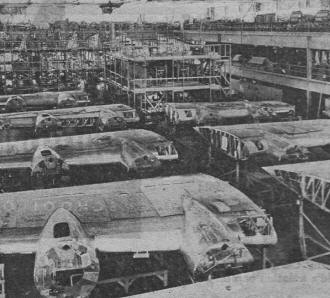
Imagine the hours that would be expended in repairing bullet holes in a
Flying Fortress! According to the author, these ships - shown here on the Boeing assembly
line - are too expensive for service.
So it is in the air. The general and the admiral must get together under one command -
a command by an airman. What America needs is an Air force, independent of both the Army and
the Navy. And as those two services have theirs, so should this Air Force have its own Secretary
of Air in Washington. Direction would then be unified under one head and many bureaus of the
Army, Navy, and Marine Corps would be eliminated. This would tend toward both efficiency,
economy, and expeditiousness.
If I were Air Corps Chief - or better still, Secretary of the Air - I'd certainly kick
over the apple-cart, and then do some bringing up to date. That is, of course, if any authority
went with the title. Let's suppose it did; that politics, bureaucracy, and opposition - had
been eliminated.
America is trying to build up the most formidable of all air services. What could we do
to aid that and speed up production of necessary planes, pilots, and observers?
Time is short; it's another bottleneck. We don't know when we'll be dragged into war, either
on the Pacific or the Atlantic side - or both - so we must hurry. The photographs of our National
Guard at maneuvers must be a tantalizing temptation for Hitler and Mussolini - trucks labeled
"tanks," stove-pipes symbolizing artillery and machine-guns, an armful of pop-guns being tendered
to Guardsmen by a police officer. Some defending force! No wonder Mussolini labels them "playboys
on parade!"
If we must hurry our rearmament, we must get away from peace-time leisure and old-time
red-tape. We must adapt new methods of manufacture as well as new war tactics. We must take
short-cuts and fight the devil with his own weapons. Pacifism and neutrality as preached by
Lindbergh is merely inviting Hitler to come and take us over. It is an invitation to invasion.
Ask any Hollander or Norwegian.
The first thing I would do as Secretary of Air would be to retire a lot of elderly ranking-officers
and replace them with men in their forties or younger - men who could adapt themselves to
new ways and who didn't live only with the Manual as their Bible; men who were airmen instead
of swivel-chair theorists. It might be mentioned that the air-generals of fallen France were
in their seventies, those of England a decade or so younger, and those of Germany are in their
forties and had flown and fought in the last war.
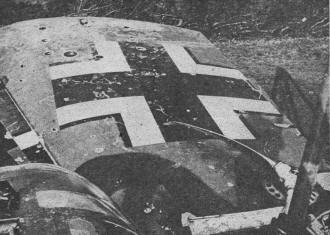
Many thousands of dollars worth of airplane completely destroyed! Even
though Nazi Messerschmitts are costly, they still are much cheaper than those constructed
by the British for the RAF and Fleet Air Arm service.
I would certainly change the present system of recruiting and training the flyer. The college
man would still be sought after as pilot material, but so would the man now barred because
of youthful disadvantages or because he wasn't born on the right side of the tracks. Every
physically-fit youth of certain qualifications would be sought. An airplane doesn't recognize
a diploma any more than it does a shovel or a sledge hammer.
In this new Air Force, the majority of the pilots would be enlisted personnel of non-commissioned
rank. This Air Force would be an army of the air. The present cry for 50,000 airplanes would
require around 200,000 pilots. That at once takes it out of the ranks of the select few and
places it among the masses. Pay for 200,000 commissioned officers would be a terrific drain,
though it might be a boon to the night clubs.
A young man recently wrote me from Uvalde, Texas. He works at just anything all week so
that he can add fifteen minutes to his log-book on Sunday. He is a real air enthusiast but
seems to lack something. He made many arduous trips to Randolph Field in San Antonio to join
the Air Corps without getting any results. Finally, they told him to go get a college degree
and then come back... Well, there are plenty of fellows like that who would be welcomed in
our new army of the air.
In the November issue of Flying Aces, I discussed the merits of the college man being trained
by the C.A.B. under the Civilian Pilots Training Program. I favored cutting down the requirements
from a college degree to a high-school diploma. In this army of the air, I go better than
that and enlist anyone for pilot training, just as the recruit is enlisted and then trained
for the cavalry or tank corps. I also pointed out the Army's difficulty of getting a mere
7,000 pilots per year under the present system. Well, enlist them and you'll get them! A real
airman doesn't care whether he's a lieutenant or a sergeant, just as long as he can fly; he
flies for the love of flying and not because of the glamour or social prestige it might bring
him. But today it's still different. And how!
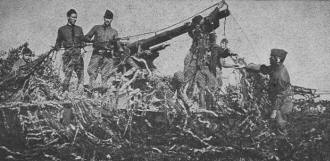
"If I were in charge of our Air Army," states Major Lord, "I would demand
more powerful anti-aircraft guns." The weapon shown is a 3-inch cannon, the type currently
in use with the U.S. Army "Archie"-fire battalions.
Just to show another waste of our airmen today, I might mention one of the many cases that
have been brought to my attention. The Government is spending money hand-over-fist to get
college boys to fly gratis, yet on the other hand they neglect shamefully pilots that are
already trained. For instance:
An enlisted man of the National Guard was recently called out with his squadron and inducted
into regular service. He's had ten years of service in his squadron during which time he has
fully prepared himself for a reserve commission in the Air Corps. He is also a licensed civilian
pilot and has hundreds of solo hours. Yet, though there are many vacancies in his National
Guard squadron, he can't get a commission there. He can't jump the gap from wearing stripes
on his sleeve to wearing a bar on his shoulder. Goodness, what officer would wish to be associated
with another who had once been an enlisted man! Neither can he get out to join the regular
Air Corps because there are but two reasons for discharge - dependents or vital work. That
man will be lost to our air defense program, his air training will be shot to hell, and he'll
even lose his license. Yet we're crying for new pilots! This fellow, too, would be glad to
fly as a rear-rank buck private, but nothing doing - they won't have him!
Well, anyhow, let's say we've got our Air Army on the way. What are the pilots going to
fly? The United States builds the sturdiest and most durable fighters and bombers in the world.
To test them, all-metal ships have been staked out in the blazing sun of our deserts and have
also withstood the buffeting and sub-zero weather of our Northern Winters. They can take it;
they won't deteriorate for years.
Such tests are swell for commercial planes, but what do they prove from a military viewpoint?
Who cares how long a fighting machine can withstand the elements? Bullets and "archie" wreck
them in a hurry and the life of a machine in action is rarely a month. It's a well known fact
that a plane is out of date even before it has run its tests. So why not build our military
airplanes cheaper?
I'd say forget all this all-metal stuff and build our planes of a steel frame with a fabric
covering. They'd be cheaper to build, easier to repair, and could be turned out a lot faster.
At least one prominent airplane designer and builder in this country agrees with me on that.
Other manufacturers stick to the most expensive sort of construction for one reason - profits.
A fabric-covered plane is easily patched up when it returns from a scrap punctured by machine-gun
bullets and shrapnel. A mechanic slaps on the necessary patches and the ship is soon ready
to go again. This can often be accomplished while the craft is being serviced.
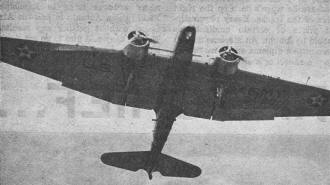
Bombers of the Martin B-10B class, or heavier, need larger landing areas
than fighters. In war time, they should be far behind the lines.
But when a metal-skinned ship is hit it's a different story entirely. Where a bullet makes
a tiny puncture, both entering and leaving a fabric covered job, it does things to a metal
ship. Here the bullet rips a hole that your hand can't cover. No patches can be slapped on
like on the fabric job. Instead, it means that more holes, rivet holes, must be drilled around
it and then the metal bent to fit the curve to be followed.
When an airplane cannon projectile explodes its way through a fabric-covered wing, the
result is serious; the hole may be two or three feet across. But when an anti-aircraft shell
blasts a metal wing, it's even more disastrous. Where the shell exits, the hole may be five
or six feet across. And that's not all! The wind catches the jagged protruding pieces of metal
skin and rips farther. Almost like a zipper, rows of rivets are torn loose and more of the
wing goes. In a few seconds the wing will be stripped bare. I've seen it happen.
The manufacturers may not make the same profits but, I say, let's build ships for a war
of bullets, not a war of attrition with the elements. Cover them with fabric and three-ply.
That way we wouldn't run into the threatened shortage of metal, either.
And why the confusing maze of instruments which a war-flyer, with his eyes glued to the
heavens, doesn't get a chance to read anyway? It's frequently said that the modern pilot is
really an engineer. Well, he can't do engineering and war flying at the same time if he expects
to live long. I'm not only talking of navigation instruments but of the whole cluttering works.
A pilot just returned from England told me he was so busy pushing this and pulling that
and watching first one instrument and then another, that he was constantly confused and spent
more of his time fiddling around that way and with his radio than he spent looking for Nazis.
And one of Hitler's ships, built to stand the gaff for only a few weeks and practically instrumentless,
got him.
Another thing. We want lots of ships in a hurry. Then let's build them smaller, for in
that way we can turn out double the number in less time. Why build pursuits so big, anyway?
Single-seater, twin-motored Allison jobs, indeed! Twelve hundred, fifteen hundred, and a couple
of thousand horses to tote around only one pilot with a few guns!
There are men in America today who can build ships with plenty of speed and maneuverability
on five to six hundred and fifty horses. And these fighters will carry just as many guns as
our present ships do. We want to fill the sky with fire-power - lead, more than anything -
and the small job can do that just as well as the largest one. In an air battle what counts
is to get the most guns on the other pilot first. So why not fill the sky with small jobs
heavily armed? For every fighter of the present trend, three smaller, equally fast ones could
be built.
Let's say that we now have our Air Army and our ships. Next, we'll need airports. At the
present there aren't a score of them in the country fit for military operations. The average
private and municipal field is too small and has too many obstructions. The more modern airports
of much acreage have lovely concrete runways, but usually neglect the rest of the field.
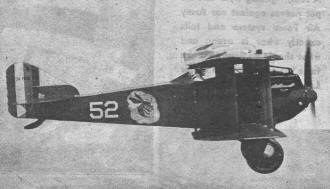
According to Major Lord, fighters should be small, cheaply-built, fabric
covered. This old Thomas-Morse MB-3A has all those features.
A military aerodrome must be an all-way field without runways. A smooth, perfectly packed
turf surface is superior to the finest runways, because in war flights and squadrons must
take-off in formation. They can't take-off down a runway, one by one, and then circle and
wait for the rest of the patrol to follow. The enemy bomber would be over his target and gone
long before enough fighters could get into formation that way.
Today, most airports are near cities and are on main highways and, railroads. That's convenient
for the airport personnel; it's also convenient for the enemy bombers. Locate a city or follow
the road or tracks and you'll come to the airport. Easy stuff!
The modern military field must be stuck out in the sticks far removed from any sort of
landmark. There must be no city, lake, or main highway or railroad near it. Access to the
field should be over camouflaged roads by motor.
The Nazis are good at this sort of thing and a tip could be taken from Ernst Udet, the
German war ace, who has been largely responsible for the camouflage of Nazi aircraft factories.
Even though the British know where the factories are, it's difficult to find them because
of lack of land marks. Many of the factories are located in vast forests and no part of them
is higher than the trees. Even the radio towers and chimneys look merely like the trunks of
tall trees.
Of course, the enemy will know the approximate location of our fields, so let's help him
a bit - and ourselves a lot. Near each perfectly camouflaged field should be a more visible
imitation drome. The enemy could waste his bombs here. We should even do as the Chinese do
and set out a few crates made of straw or boards for him to practice on.
Camouflage is so perfected today that a field can be made indiscernible from a thousand
feet altitude. It can be made to look like a cut-up farm, a crossroads, a grain field, trenches,
or even a lake. Even in the first world war our hangars could not be easily seen. Large nets
covered with tufts of grass or straw the color of the field were draped over the hangar. More
than once I've circled an area, knowing that I was over the aerodrome, but had to look long
and hard before finally seeing where to land.
But even the best hidden field can be found and destroyed. Plans must be perfected to,
overnight, build new fields. Just as Italy used steel mesh for road-beds in Ethiopia, so we
should have huge rolls of steel mesh netting stored in strategic places to be used for the
hurried laying of landing areas.
Say we were invaded in a section where we wanted to concentrate our fighting planes. Bombers
usually object· to fighters using the same field as it attracts too much attention, so the
fighters would have to provide landing areas for themselves. Perhaps the regular field had
been bombed into uselessness, or it was too far from the front for the fighters and interceptors.
Time and equipment were lacking to build a graded field, so out would come the rolls of mesh
and in no time there would be a landing area.
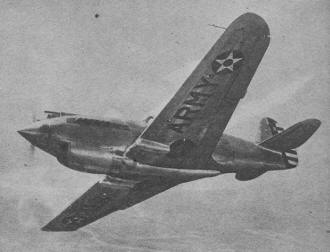
More than $40,000 worth of airplane for only one man and four guns! Fighters
should be more compact and have less powerful engines than this Allison-powered Curtiss Army
P-40 Hawk.
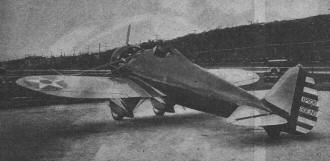
About the closest America in recent years has come to building a real war
machine is this Boeing P-26A. It didn't carry too many unnecessary instruments and was an
airman's airplane.
Though the terrain might be swampy land or growing crops, the heavy steel nets could be
quickly stretched over it to make it satisfactory for fighter aircraft. Such fields are now
being utilized by the British at Hell's Corner and both Spitfires and Hurricanes use them.
From the air, they look merely like the rest of the hops field or the vineyard over which
the nets are laid.
Now let's suppose that we've got our unified Air Army, which instead of taking orders from
the Army, Navy, and Marines, will probably be giving orders to all of them. It takes an engineer
and highly trained technician to operate even the modern fighter, so we've replaced that with
a small, fast ship which is simple enough for the average, quickly trained man to operate.
And we've got camouflaged military dromes, dummy fields, and emergency landing areas of steel.
These are the main things we needed, so now let's go to work and smooth out the finer points.
Among the many things abetting the collapse of France was the fact that her infantry was
unfamiliar with air tactics and airplanes, as Pierre Cot stated in December Flying Aces. The
sight of Nazi Stukas in swarms drove the pilots to fear and panic; he neither knew how to
defend himself, nor how to fight off the sky-terror. The German tanks and infantry, on the
other hand, cooperated perfectly with the dive-bombers. They had a perfectly planned offensive
in which each had just a certain job to do at a certain time. Their knowledge of each other's
methods was obvious.
Each pilot-enlistment of our Air Army should be just as well versed in the other branches
of the service as are the Nazis. Each would be required to serve a short time with the tanks,
infantry, and artillery to familiarize him with their methods. In the same way, officers of
the other services would serve a short time with the Air Army to learn something of aviation.
All services would study methods of cooperation with each other. Soon the glamour or glory
of belonging to a certain service, or wearing a particular insignia on the uniform would be
erased and the airman and tank driver would become pals; then we'd have real cooperation in
the Army. (Editor's note: See Lieut. Commander Preston S. Lincoln's article, "The Case Against
an Independent Air Force!")
In our Air Army we've incorporated the experiences and ideas of each man at our round table
and now we probably have the formidable war-machine that America hopes for. Where Hitler and
Mussolini had derided and belittled democracy as a decadent idea, they now pray daily that
America is the peaceful nation we claim to be and that we will not leave these shores to go
forth and slay the dragon in the knights of yore fashion.
Posted October 14, 2017
|